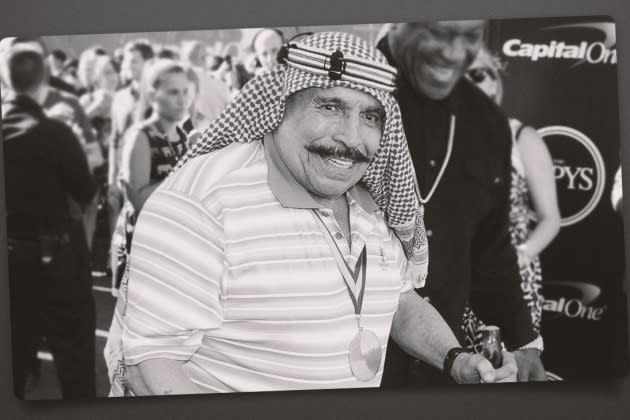The Iron Sheik, Villainous Pro Wrestler From Iran, Dies at 81
- Oops!Something went wrong.Please try again later.
- Oops!Something went wrong.Please try again later.
- Oops!Something went wrong.Please try again later.
- Oops!Something went wrong.Please try again later.

Hossein Khosrow Vaziri, the Iran-born wrestler known as the Iron Sheik, who channeled America’s hatred of his homeland to build a career as one of the most despised ring villains of his era, died Wednesday. He was 81.
“Today, we gather with heavy hearts to bid farewell to a true legend, a force of nature and an iconic figure who left an incredible mark on the world of professional wrestling,” read a statement posted to the Iron Sheik’s Twitter account announcing his death. The WWE also paid tribute on Twitter; a cause of death was not disclosed.
More from The Hollywood Reporter
Sheldon Harnick, Famed 'Fiddler on the Roof' Lyricist, Dies at 99
Jim Tweto, 'Flying Wild Alaska' Star, Dies in Plane Crash at 68
A former bodyguard for the Shah of Iran, Vaziri came to the U.S. in the late 1960s. For his wrestling persona, he shaved his head, grew a mustache, sported a ghutra headdress and curled-toe boots, and swung a pair of 75-pound Persian meels above his head as a demonstration of his strength.
His signature move was the back-breaking “Camel Clutch” submission hold.
As more than 60 Americans were being held hostage at the U.S. Embassy in Tehran starting in November 1979, the Sheik went all in, waving an Iranian flag and singing his country’s national anthem in the ring, spitting on the floor during interviews and proclaiming, “Iran No. 1.”
“It was just the right time to establish my character or my gimmick to be the real baddest, baddest wrestler on the Earth,” he recalled in the 2014 documentary The Sheik, directed by Igal Hecht.
During the 1990-91 Gulf War, his character was repackaged as Iraqi sympathizer Col. Mustafa and teamed with the American turncoat Sgt. Slaughter (Robert Remus) and General Adnan (Adnan Al-Kaissie), a high school classmate of Iraq President Saddam Hussein back in the day. The trio then headlined SummerSlam 1991 in a handicap match against Hulk Hogan and the Ultimate Warrior.
The Sheik finished off Bob Backlund at New York’s Madison Square Garden in December 1983 to win the WWE heavyweight title. A month later, he lost the belt (and would never get it back) when Hogan broke out of a Camel Clutch and connected with a leg drop to give birth to “Hulkamania.”
“After the match, the Sheik was a good sport,” Hogan wrote in his 2009 memoir, Hollywood Hulk Hogan. “Even though he put me over and made me world’s champion that night, he came backstage and gave me a big hug.”
The Sheik told Hogan that Verne Gagne, a promoter with the American Wrestling Association, had offered him $100,000 to break Hogan’s leg that night as payback for the Hulkster quitting the AWA to join the WWE in 1983. He said he refused.
Born on March 15, 1942, and raised in Tehran, Vaziri volunteered for the army at age 18 but continued to wrestle as an amateur. He became a national champion and served as the Shah’s bodyguard whenever the leader and his family visited Persepolis and Shiraz.
He was a great admirer of his country’s most famous Olympic wrestler, Gholamreza Takhti. When Takhti was found dead of an apparent suicide in his hotel room in early 1968, theories circulated that he had been murdered, spurring Vaziri to leave the country.
“If Iran is no good for Gholamreza Takhti, the greatest champion we had, Iran is never going to be good for me. So I decided to come to America,” he said.
In Minnesota, he was hired as an assistant coach for the U.S. Olympic wrestling team that competed at the 1972 Munich Games.
The next year, he trained with Ric Flair at Gagne’s wrestling school and paid his dues working as a referee and setting up the ring before shows. “I was married to the wrestling mat,” he said. “Because I was so much fallen in love with the sport, I didn’t care about girls.”
But in 1976, he married Minnesota native Caryl Peterson. Their best man at the wedding was wrestling announcer “Mean” Gene Okerlund — or “Gene Mean,” as he would call him during interviews.
He had a feud with Slaughter that came to a head in a bloody 1984 loss at the Garden in a memorable “Boot Camp” match. Managed by “Classy” Freddie Blassie, he then partnered with Russian Nikolai Volkoff to take the Tag Team title at the first WrestleMania in 1985.
Vaziri and wrestler Jim Duggan were traveling together in 1987 when they were pulled over by New Jersey State police. Vaziri was charged with possession of cocaine and marijuana, Duggan was charged with possession of marijuana, and both were suspended by the WWE.
In the ’90s, the Sheik made a brief reappearance in the WWE as co-manager, with his former rival Backlund, of Middle Eastern wrestler the Sultan. And he returned to action in 2001 at WrestleMania 17, defeating 18 other alumni to win the “Gimmick Battle Royal” at age 59.
In 2003, his eldest daughter, Marissa, then 27, was murdered by her boyfriend.
Although he started his hall-of-fame career as a heel, the Sheik had his admirers.
“With his Persian clubs and his incredible wrestling background and soldier’s mentality, he represented how there is no success without struggle,” said Dwayne “The Rock” Johnson. “He represented that hard work pays off. He was all things that make America great.”
At the end of his documentary, the Sheik asks that he be remembered as “a real good man, good sport man, real tough man in my young day. I was many years the villain, bad guy, heel, but now I’m a good guy.”
Best of The Hollywood Reporter

